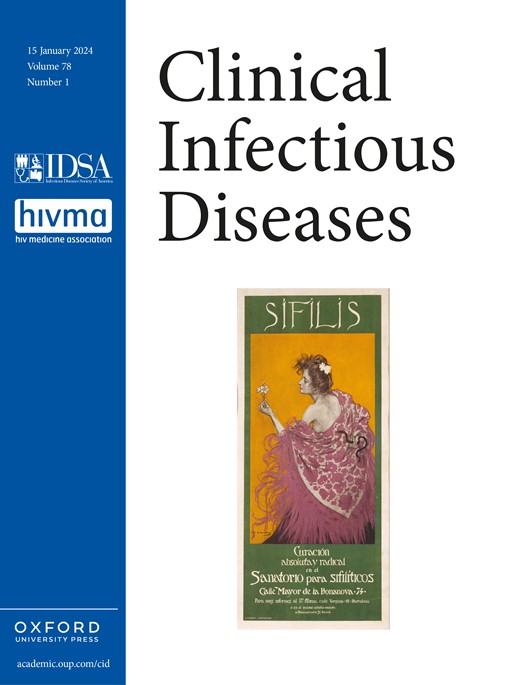使用自愿隔离中心与减少家庭 SARS-CoV-2 传播之间的关系:加拿大多伦多的一项匹配队列研究
IF 8.2
1区 医学
Q1 IMMUNOLOGY
引用次数: 0
摘要
背景在 COVID-19 大流行期间,许多地区都建立了隔离中心,以帮助减少家庭传播;然而,很少有实际研究支持其有效性。我们比较了在疫苗广泛供应之前,首例病例使用多伦多自愿隔离中心(TVIC)的家庭与接受常规自我隔离指导的家庭之间的传播风险。方法 将 2020 年 9 月至 2021 年 3 月期间出现症状的首例病例的家庭与最多 10 个自我隔离家庭进行倾向得分匹配。对于 TVIC 家庭,随访从报到次日开始;对于匹配的自我隔离家庭,随访从首例病例症状出现后的同等延迟时间开始。结果采用比例危险模型对 28 天二次发病率进行分析。结果 303 个 TVIC 家庭与 2943 个自我隔离家庭进行了配对。从首次发病到 TVIC 登记入住的中位时间为 3 天(IDR [十位间范围]=1-6 天);中位退房日期为发病后 11 天(IDR=10-13 天)。TVIC 家庭的发病率为 5.2%(53/1,015),而自我隔离家庭的发病率为 8.4%(787/9,408)(危险比 [HR] =0.50,95% 置信区间 [CI] =0.28-0.90)。在症状出现后较早进行首次隔离(HR=0.37,95% 置信区间:0.13-1.04)、规模较大(HR=0.30,95% 置信区间:0.14-0.67)和较为拥挤(HR=0.34,95% 置信区间:0.15-0.77)的家庭中,观察到更大的减少率。结论 在疫苗上市之前,使用自愿隔离中心可使家庭 SARS-CoV-2 感染率降低 50%。除 SARS-CoV-2 外,自愿隔离中心还有助于控制其他传染病或未来大流行病原体的复发,尤其是对隔离有困难的人。本文章由计算机程序翻译,如有差异,请以英文原文为准。
Association between use of a voluntary isolation centre and reduced household SARS-CoV-2 transmission: A matched cohort study from Toronto, Canada
Background Throughout the COVID-19 pandemic, many jurisdictions established isolation centres to help reduce household transmission; however, few real-world studies support their effectiveness. We compared the risk of transmission among households where first cases used the Toronto Voluntary Isolation Centre (TVIC) compared to households receiving routine self-isolation guidance, prior to widespread vaccine availability. Methods Households with a first case having symptom onset between September 2020, and March 2021, that used TVIC, were propensity-score matched with up to 10 self-isolation households. Follow-up began for TVIC households on the day after check-in, or for matched self-isolation households, the equivalent delay since first case symptom onset. The outcome, 28-day secondary attack rate, was analyzed using proportional hazards models. Results 303 TVIC households were matched with 2,943 self-isolation households. Median duration from first case symptom onset to TVIC check-in was 3 days (IDR [interdecile range]=1-6 days); median check-out date was 11 days after onset (IDR=10-13 days). The attack rate among TVIC households was 5.2% (53/1,015) compared to 8.4% (787/9,408) among self-isolation households (hazard ratio [HR]=0.50, 95% confidence interval [CI]=0.28-0.90). Greater reductions were observed when first cases isolated sooner after symptom onset (HR=0.37, 95%CI: 0.13-1.04), and in larger (HR=0.30, 95%CI: 0.14-0.67) and more crowded (HR=0.34, 95%CI: 0.15-0.77) households. Conclusions Use of a voluntary isolation centre was associated with a 50% reduction in household SARS-CoV-2 attack rate, prior to the availability of vaccines. Beyond SARS-CoV-2, voluntary isolation centres may help control resurgences of other communicable infections, or future pandemic pathogens, in particular for individuals experiencing difficulties isolating.
求助全文
通过发布文献求助,成功后即可免费获取论文全文。
去求助
来源期刊

Clinical Infectious Diseases
医学-传染病学
CiteScore
25.00
自引率
2.50%
发文量
900
审稿时长
3 months
期刊介绍:
Clinical Infectious Diseases (CID) is dedicated to publishing original research, reviews, guidelines, and perspectives with the potential to reshape clinical practice, providing clinicians with valuable insights for patient care. CID comprehensively addresses the clinical presentation, diagnosis, treatment, and prevention of a wide spectrum of infectious diseases. The journal places a high priority on the assessment of current and innovative treatments, microbiology, immunology, and policies, ensuring relevance to patient care in its commitment to advancing the field of infectious diseases.
 求助内容:
求助内容: 应助结果提醒方式:
应助结果提醒方式:


